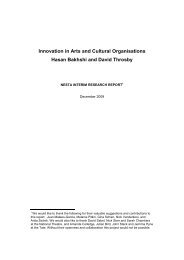Rumbling on performativity_Frits Simon
Rumbling on performativity_Frits Simon
Rumbling on performativity_Frits Simon
You also want an ePaper? Increase the reach of your titles
YUMPU automatically turns print PDFs into web optimized ePapers that Google loves.
dow Mantere and Vaara’s interpretati<strong>on</strong>s. Cloaked in c<strong>on</strong>cepts as ‘wisdom of the<br />
crowd’ (Surowiecki, 2004) and ‘co-creati<strong>on</strong>’ (Wierdsma, 2005) at that time I hoped<br />
that a lot of colleagues would grab the opportunity to participate. I expected that<br />
public engagement would promote the identificati<strong>on</strong> of all involved with a new strategy<br />
and thus also would promote an easy realizati<strong>on</strong>. Things turned out otherwise:<br />
distrust and aloofness regarding management issues partly explained the lack of<br />
participati<strong>on</strong> (Schutte et al., 2009). C<strong>on</strong>trary to Mantere and Vaara and based <strong>on</strong> my<br />
experiences in that project I doubt if dissent can be easily traded in for participati<strong>on</strong><br />
and engagement. Apparently another perspective is needed.<br />
The research of Mantere and Vaara illustrates what Stacey (2010) calls the new jarg<strong>on</strong><br />
of management writers as they suggest that by definiti<strong>on</strong> participati<strong>on</strong> creatively<br />
produces good outcomes. However, c<strong>on</strong>trary to the in my view rather naïf c<strong>on</strong>clusi<strong>on</strong>s<br />
of Mantere and Vaara, I would say that power is unavoidably present, also when a<br />
strategy is developed in a micro-oriented or emergent way (Groot, 2007; Groot and<br />
Homan, 2012).<br />
Power & soft c<strong>on</strong>straining: a panoptical perspective <strong>on</strong> encouraging dissent<br />
From a leading critical perspective <strong>on</strong> organizati<strong>on</strong> and management studies the<br />
research of Mantere and Vaara expresses what Aardema (2010) sees as a recent trend<br />
in public administrati<strong>on</strong>: realizing the importance of soft, organic and incremental<br />
organizati<strong>on</strong>al development. Aardema w<strong>on</strong>ders whether these soft approaches are<br />
wolves in sheep’s clothes.<br />
According to the perspective of Critical Management Studies (CMS) no w<strong>on</strong>dering is<br />
needed. Within CMS it is argued that soft c<strong>on</strong>trols and soft managerial practices and<br />
policies have supplanted hierarchical and bureaucratic c<strong>on</strong>trol, but still can be characterized<br />
as affirming managerial hegem<strong>on</strong>y and exclusi<strong>on</strong>. These practices lock people<br />
in (Alvess<strong>on</strong> and Willmott, 2012). Many organizati<strong>on</strong>s have become soft bureaucracies<br />
(Courpass<strong>on</strong>, 2000) or claim to be post-bureaucratic (Alvess<strong>on</strong>, 2013). Soft bureaucracies<br />
are organizati<strong>on</strong>s in which centralizati<strong>on</strong> of policy is sustained by the coercive<br />
force of so called external threats and ineluctable decisi<strong>on</strong>s, and stimulating competiti<strong>on</strong><br />
between people (e.g. performance appraisals, growing number of temporarily<br />
assignments, project-based organizati<strong>on</strong>). Post-bureaucratic organizati<strong>on</strong>s claim to be<br />
decentralized, flexible and n<strong>on</strong>-hierarchical, operating <strong>on</strong> the basis of networking,<br />
mutual adjustments and shared values. Clearly noticeable and face-to-face power<br />
mechanism are replaced by soft technologies and combined with increasing c<strong>on</strong>trol<br />
and pressure <strong>on</strong> performances (Clegg et al., 2006). C<strong>on</strong>trol and power differences are<br />
made more or less invisible by hiding them in external inevitabilities, HR-instruments,<br />
inspiring visi<strong>on</strong>s and corporate values, and by declaring these instruments applicable<br />
to every high- or low-ranked organizati<strong>on</strong> member (Courpass<strong>on</strong> and Thoenig, 2008;<br />
Steffy and Grimes, 1992; Townley, 2005). They are labelled as transparency technologies<br />
(Levay and Waks, 2009), needed in the exotic, multifaceted bazaars organizati<strong>on</strong>s<br />
often are nowadays (Courpass<strong>on</strong> and Thoenig, 2008). Modern soft bureaucracies have<br />
6. A case of c<strong>on</strong>sent about dissent | 157



